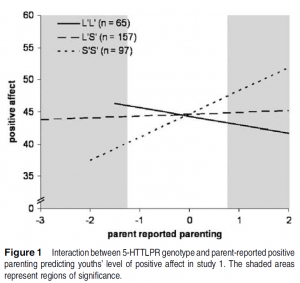Traditional models of child emotional-behavioral problems often posit the presence of genetic “vulnerabilities” that can be realized in the presence of specific environmental triggers. A series of new studies, however, suggest that some genes may make children more sensitive to both negative and positive environments.
Three separate studies that were published together examine the interaction between parenting, mood, and the famous 5-HTTLPR gene which codes for the serotonin transporter promoter and has been linked previously to depression and anxiety. 
While the methodologies of each study varied slightly, each assessed gene status of the children, parenting quality, and the child’s overall affect. Overall, youth with two copies of the short allele (shown as S/S in the figure) tended to have more negative affect when there was more negative parenting but also had more positive emotions in the presence of more positive parenting. The results strongly suggested evidence for what has been called a genetic environmental interaction (G X E).
The authors concluded that genes like 5-HTTLPR may be better conceptualized as an environmental responsivity gene more than a vulnerability gene.
One limitation of these studies were their naturalistic and associative design which somewhat limits the degree to which cause and effect can be determined. Nevertheless, these new studies illustrate the possibility that in many cases, children don’t have “bad” genes but rather genetic influences that with the right environment can lead to very positive outcomes.
Reference
Hankin BL, Nederof E, Oppenheimer CW, et al. Differential susceptibility in youth: Evidence that 5-HTTLPR x positive parenting is associated with positive affect ‘for better and worse.’ Trans Psychiatry, e44, 1-7.

